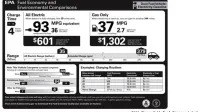EV Fuel Economy Labels: Your Mileage May Vary (A Lot)

Under EPA testing the Leaf was found to have a 73-mile range and would consume 34 kWh of electricity to travel 100 miles .
The Volt label is even more confusing, because it has both the mpg-e numbers like the Leaf, for its EV mode, as well as a conventional miles per gallon number — a mere 37 — for its gasoline-electric hybrid mode. We’ll come back to the Volt label shortly, but there’s another big confusing number to deal with first.
That’s the annual cost part of the label, in which the Leaf is pegged at $561. That number is based on an electric rate of 11 cents per kWh and an annual mileage of 15,000. The Chevy Volt label derives its $601 annual operating cost from the same set of assumptions if the car is run on electricity alone, while also quoting a $1,302 figure for the foolish owner who never recharges their Volt but pays $3.20 per gallon for gasoline.
While these dollar values are merely rough estimates of the relative costs of operating these vehicles, it stands to reason that these numbers are going to be much more variable for EV’s than for gasoline-powered vehicles. That’s because the price of electricity in the U.S. has a greater regional delta than the cost of gasoline. Electric rates also vary depending upon time of day, so some consumers are going to pay much more, perhaps two or three times those electricity prices, depending on where they live and what time of day they charge their car. By comparison, you’d be hard-pressed to find a fueling station in the continental U.S. selling gas for twice the going rate in another state.
At least one review of the Volt, from Edmunds.com, claims it actually cost more to run the vehicle on electricity than gasoline, due to the high cost of local electric power.
The Volt’s unique operation – travelling roughly 35 miles on electric power alone, before switching into what is essentially a gasoline-electric hybrid mode – makes it challenging to quantify fuel economy. Yet the label does little to clarify the situation, as the bifurcated layout makes it seem like the Volt runs on either electricity or gasoline, when in fact, the car is designed to use electricity most of the time. Some language included on the label like, “When electricity is used up” doesn’t accurately describe the way the Volt actually works, since even when the Volt switches out of EV mode, it still has plenty of electricity stored in the battery – electricity that is used to power the vehicle while it is operating like a hybrid.
Perhaps the worst aspect of the Volt label comes in its cost calculations for the owner who never recharges his car. The likelihood of a Volt being used exclusively in “gas only” mode for an entire year is as remote as it would be preposterous, yet the Volt label displays this information.
All this carping aside, the EPA will be unveiling new fuel economy labels for 2012, so at least the limitations of these 2011 labels will have the opportunity to be addressed.




